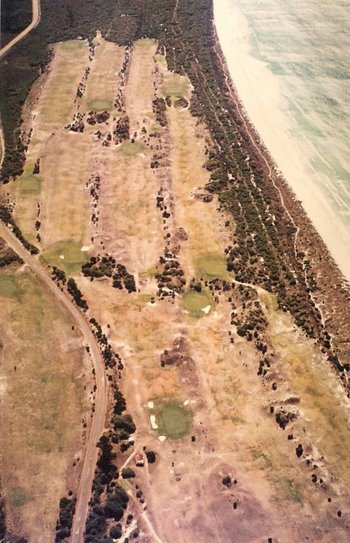In 2010 the course was listed in the State register of heritage places.
The Albany Golf Club is the oldest in WA still on its original site and the only 18-hole course to be listed in the State Register of Heritage Places. The course is also included in the National Trust List of Classified Places.
Foundation
In 1898 the editor of the Albany Advertiser, William Forster, advocated that a 9-hole links be established amongst the dunes between Middleton Beach and Lake Seppings. The idea was enthusiastically taken up by a small group of prominent Albany citizens, amongst them the club’s first captain, Dr Thomas Robinson, and its first secretary, Charles Keyser.
The club was officially formed in September 1899 and the course opened on 3 February 1900 by inaugural President the Hon SJ Haynes MLC. There were 38 members, all male. Ladies were confined to afternoon tea duties with the occasional informal game until 1908; they were granted their own club day in 1916.
The Course
Surveyor William Angove’s layout utilised the Middleton Beach dune system to create a course reminiscent of the best Scottish links. Thirty- five acres were cleared by a contractor assisted by volunteers, and greens turfed and fenced to protect them from the sheep that ‘mowed’ the fairways. Constructing the original 9 holes cost £100 raised from the sale of £10 debentures to members.
The club always had an 18-hole course in mind but two world wars and the Depression intervened and it was not until 1963 that the current 18-hole layout was finally achieved, designed by prominent member, Bill Anderson. Several of the new holes provided superb views of the ocean, but with little protection from strong summer easterlies.
The 18-hole layout around the time of its opening in 1963
A significant improvement came in 1974 with the re-routing of Golf Links Road to the west of the course. In 1988 each hole was named to reflect its chief characteristic and in 2000, construction of the current clubhouse required renumbering of the holes.
The course some 60 years after the opening of the 18 hole layout
Clubhouses
For the first decade members had little more than a shed for shelter but in 1910 the first purpose built clubhouse was opened with just two rooms; one serving as the gentlemen’s lounge and locker room and the other, the ladies’ tea room and locker room.
The 1910 clubhouse, photographed in 1923
The building was doubled in size in 1925 then relegated to change rooms alongside the new 1955 clubhouse and finally demolished to make way for major extensions and refurbishment in 1968. The current clubhouse was built at the northern end of the course and opened in 2000.
1925 addition of second gable, photographed in the early 1930s
1955 new clubhouse adjoining the old building dating from 1910
1968 extension
Current clubhouse, opened in 2000
The Wittenoom Cup
The Wittenoom Cup, and its associated events, is the most important event on the AGC calendar. It can be traced back to 1913, when the club ran its first Albany Golf Club Carnival as part of an annual six week Albany sporting carnival. In 1927 club president Charlie Wittenoom presented a cup for the main event of what was to become known as the Wittenoom Cup Carnival, now running over nine days and attracting players from around 30 clubs throughout WA.
Charlie Wittenoom made an enormous contribution to the Albany Golf Club as well as to Albany and indeed WA. He was president of the AGC from 1926 until 1952, Mayor of Albany for 17 years and MLC, South East Province, for 12 years. His forceful personality and successful business skills guided the club through difficult times, from coping with financial worries during the Depression, to achieving reliable course reticulation, the construction or extension of three clubhouses as well as involvement in early planning for the 18 holes which, as Patron of the club, he officially opened in May 1963.
Charlie Wittenoom
For a full history of the club’s first 125 years, see ‘Albany Golf Club. Celebrating 125 years’










